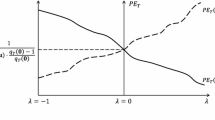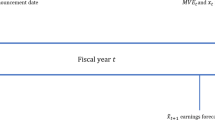Abstract
This paper develops a parsimonious model relating a firm’s price per share to, (i), next year expected earnings per share (or 12 months forward eps), (ii), short-term growth (FY-2 versus FY- l) in eps, (iii), long-term (asymptotic) growth in eps, and, (iv), cost-of-equity capital. The model assumes that the present value of dividends per share (dps) determines price, but it does not restrict how the dps-sequence is expected to evolve. All of these aspects of the model contrast sharply with the standard (Gordon/Williams) text-book approach, which equates the growth rates of expected eps and dps and fixes the growth rate and the payout rate. Though the constant growth model arises as a peculiar special case, the analysis in this paper rests on more general principles, including dividend policy irrelevancy. A second key result inverts the valuation formula to show how one expresses cost-of-capital as a function of the forward eps to price ratio and the two measures of growth in expected eps. This expression generalizes the text-book equation in which cost-of-capital equals the dps-yield plus the growth in expected eps.
Similar content being viewed by others
References
R. A. Brealey S. C. Myers (1991) Principles of Corporate Finance EditionNumber4 McGraw-Hill New York
Botosan, C. A. (1997). “Disclosure Level and the Cost of Equity Capital.” The Accounting Review 72, S323–S349
Claus, J. and J. Thomas. (1998). “The Equity Risk Premium is Much Lower than you Think it is: Empirical Estimates from a New Approach.” Working paper. Columbia University
A Damodaran (1997) Corporate Finance: Theory and Practice Wiley New York
Easton, P., G. Taylor and P. Shroff. (2000). “Empirical Estimation of the Expected Rate of Return on a Portfolio of Stocks.” Working paper. University of Melbourne
E. J. Elton M. J. Gruber (1995) Modern Portfolio and Investment Analysis EditionNumber5 John Wiley New York
Fama, E. F. and K. R. French. (2000). “The Equity Premium.” CRSP Working Paper No. 522. University of Chicago
Feltham, G. and J. A. Ohlson. (1995). “Valuation and Clean Surplus Accounting for Operating and Financial Activities.” Contemporary Accounting Research 11, 689–731
Gebhardt, W., C. Lee and B. Swaninathan. (1999). “Towards an Ex ante Cost-of-Capital.” Working paper. Cornell University
Ohlson, J. A. (1998). “Comments on an Analysis of Historical and Future-oriented Information in Accounting-based Security Valuation Models.” Contemporary Accounting Research (Summer)
Ohlson, J. A. (2000). “Residual Income Valuation: The Problems.” Working Paper. Stern School of Business. New York University
Zhang, X.-J. (2000). “Conservative Accounting and Equity Valuation.” Journal of Accounting and Economics Forthcoming
Author information
Authors and Affiliations
Rights and permissions
About this article
Cite this article
Ohlson, J.A., Juettner-Nauroth, B.E. Expected EPS and EPS Growth as Determinantsof Value. Rev Acc Stud 10, 349–365 (2005). https://doi.org/10.1007/s11142-005-1535-3
Issue Date:
DOI: https://doi.org/10.1007/s11142-005-1535-3




